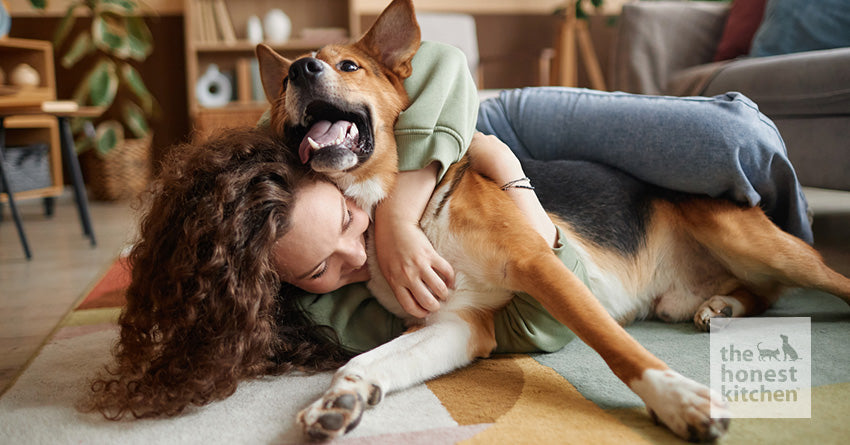Dog ownership is still on the rise, with the percentage of dog owners in the U.S. increasing more between April 2022 and April 2023 than at any point in the previous five years.
If you’re considering becoming a first-time dog owner, there are probably dozens of questions you’re asking yourself to determine if a dog is right for your lifestyle. And that’s before you even begin looking at all the different dog breeds!
In this article, we’ll cover essential tips for new dog parents, including lifestyle considerations, how to prepare your home for a dog, supplies you’ll need, and more.
Consider These Lifestyle Factors When Choosing a Dog
Living Space Size and Dog’s Size
Before becoming a pet parent, you should look at your living situation and determine what size dog your home could support. A Great Dane, for example, would not thrive in a studio apartment. If moving to a larger space isn’t an option, consider adopting a breed that needs less space, such as a spaniel or terrier.
Consider your outdoor space as well. An active dog that loves running and playing outdoors will be much better off with a large fenced-in yard that they can access regularly. But a chihuahua or pomeranian might be perfectly happy to snooze the day away on the couch.
Working From Home or Away
You’ll also want to consider different breeds’ emotional temperaments. Some dogs are more prone to separation anxiety, which could be an issue if you work away from home.
Breeds prone to anxiety include Labrador retrievers, border collies, Jack Russell terriers, and bichon frises. On the flip side, some independent dog breeds include basset hounds, American foxhounds, pugs, and chow chows. For the best life for you and your pup, choose a dog breed that aligns with your lifestyle.
Energy Level and Attention Needs
Next, consider each dog breed’s energy level and attention needs. Attention and temperament often overlap, but energy level is something different.
A dog with higher energy levels requires more from their owners, such as time walking, running, and playing. Some dog breeds known for their high energy levels include Alaskan malamutes, American foxhounds, doberman pinschers, golden retrievers, and sheepdogs.
Grooming Needs
Pet owners may not consider grooming needs upfront, but it can be a large lifestyle adjustment when your pup sheds a lot. If brushing your dog regularly and vacuuming every day is not your style, it may be best to avoid dogs that shed a lot.
Some of the furriest dogs include huskies, Bernese mountain dogs, chow chows, golden retrievers, and sheepdogs. Dogs that don’t shed much include bichon frises, miniature schnauzers, poodles, Malteses, and West Highland terriers.
Other Pets at Home
Beyond the attributes of certain breeds, it’s important to make sure your new dog will get along with your other pets if you have any. Introducing cats and dogs, in particular, can be a tricky process.
Individual dogs can vary based on their histories and personalities, but some breeds that typically get along with cats include retrievers, bulldogs, collies, and beagles.
Kids at Home
Finally, the presence of kids at home is an important consideration when choosing a type of dog breed. Similar to compatibility with other pets, some dogs have personalities and histories that make them more or less suited to live with children.
Generally speaking, retrievers are known for being great family dogs, as are bulldogs, beagles, Irish setters, and Newfoundlands.
Tips for Preparing Your Home for a New Dog
Dog-Proofing Your Home — Indoors
Puppy-proofing your home is like child-proofing your home, so if you already have kids, this list may sound familiar.
-
Must-do
Put toxic chemicals or medications out of the dog's reach.
Remove poisonous and toxic houseplants.
Place dangling electrical cords from lamps, TVs, or stereos out of reach.
Put away small items that are choking hazards.
Keep all sharp objects out of your pup’s reach.
-
Should-do
Keep toilet seats down and washing machine doors closed.
Secure trash cans.
Keep treats out of reach to avoid a doggie break-in — and a mess.
Set up baby gates if there are children in the home.
-
Nice-to-have
Make sure to keep closet doors closed to ensure your curious pup doesn’t chew up shoes or clothing.
Dog-Proofing Your Home — Outdoors
When it comes to the outside of your home, here are some recommendations to keep your dog safe and healthy.
-
Must-do
Avoid using chemicals like rat poison, weed killer, or non-pet-safe salt.
Remove toxic plants that are within your dog’s reach.
-
Should-do
Ensure you have a fence high enough your dog cannot jump over, or install an invisible fence.
If you have a pool, install a fence around it.
Clean up after your dog as soon as possible, as puppies may try to eat their own poop.
Be cautious of hot days. Limit your dog’s exposure to heat and provide a shaded area and fresh, cool water.
-
Nice-to-have
Keep your lawn trimmed and brush under control to support your pup’s coat and general hygiene (ticks are more likely to hide in tall grass).
Supervise your dog while outside, especially if they are still a puppy.
Plants That Are Harmful to Dogs
As noted above, there are indoor and outdoor plants that are toxic to dogs. So be sure to keep these plants out of your pup’s reach, or avoid them in your home or yard altogether:
Aloe vera
Ivy
Jade
Dumb cane
Philodendron
Pothos
Sago palm
ZZ plant
Elephant ear
Corn plant
Asparagus plant
Desert rose
Bird of paradise
Lilies (all varieties)
Chinese evergreen
Azaleas
Tulips
The good news is that there are pet-safe plants you can feel confident having in your home, including spider plants, African violets, and bamboo. If you’re unsure about a specific plant or think your dog may have eaten a poisonous plant, call your veterinarian or the Animal Poison Control Center .
Supplies You’ll Need as a New Dog Owner
Types of Beds
When it comes to dog beds, size and material are the two most important factors. It’s best to choose a dog bed that is big enough for your dog to lie down in their natural position and be fully on the bed.
In terms of material, you may consider choosing a bed with a washable cover that can withstand wear and tear. However, dogs that tend to overheat might prefer an elevated mesh bed that will keep them cool.
Finally, consider your pup’s age. Older dogs with aches and pains may benefit from an orthopedic or memory foam bed that better supports their joints.
Food and Dishes
When you choose a food dish, be sure to choose one that aligns with your dog’s size, and consider the material of the food and water bowls. Choose a material that is durable and can withstand constant cleaning, such as stainless steel or ceramic.
Last, consider the height and shape of your dog’s dishes. An elevated dog bowl (no higher than your pup’s shoulders) can help with digestion and can remove the risk of them tipping their bowl over. Also, pups with long, floppy ears will prefer deeper, narrower bowls that keep their ears out of their food and water.
Toys for Playing and Mental Fitness
Whether your dog is high-energy or lower-energy, toys for playing and mental stimulation are a must.
Consider choosing toys that you and your dog can play with together, as well as some that your pup can use independently when you’re away. Tug toys and balls are great for playing together, while stuffies, puzzles, and chew toys will keep your dog entertained while they’re alone.
Leashes
Leashes should be well-designed, guaranteed not to break, and ideal for your dog’s size. If your pup is big and strong, you may consider a thicker leash combined with a harness. On the other hand, if your dog is a small breed, a standard dog leash may do.
And be sure to consider the length of the leash. Standard leashes are anywhere from four to eight feet long, but you should take into account how well-trained your dog is and your local area’s leash laws.
Treats
Treats can be a helpful tool when puppy training. However, it’s important to choose the right kind of treats. There are many different types of treats out there, so be sure to choose treats that align with the size and health of your dog.
Large breed dogs can handle larger, crunchier treats better than small breed dogs, due to the size of their jaws. Also, older dogs with bad teeth may need smaller, softer treats, while overweight dogs will be better off with lower-calorie options like pieces of fruit or vegetables.
Consider Pet Insurance
Pet insurance has become popular in recent years, and for good reason. Emergency treatment for an illness or accident can cost a lot of money. With pet insurance, you can feel more at ease knowing your furry friend is covered for certain healthcare concerns.
There are several reputable pet insurance companies, so if you’re interested, check out their offerings and reviews to identify which one may be right for you and your new pup.
Why It’s Important for New Dog Owners To Have a Routine
Adjustment and Behavior
Playtime and Rest Time
Meals and Treats
Tips for Training Your Dog as a New Owner
Positive Reinforcement and Patience
Socializing Your Dog With Other Animals
Socializing Your Dog With Kids and Strangers
Make Healthy Food Choices for Your Pup With The Honest Kitchen
Bringing a new dog home is an exciting adventure and, as we’ve laid out in this article, also something that requires planning and preparation. Whether you’re struggling to decide which dog bed to purchase or researching the latest and greatest training tips, it can feel overwhelming.
But one area that we can help you cover is your dog’s nutritional needs. By choosing dog food and treats from The Honest Kitchen, you can be confident your pup is receiving a human-grade diet full of essential nutrients and big flavor.
Check out The Honest Kitchen’s dog food collection to find the perfect fit for your new best friend.




